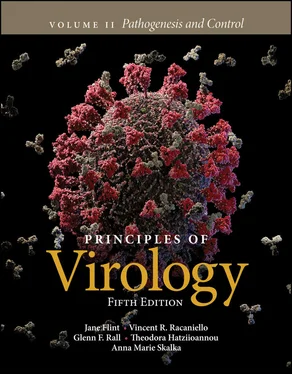S. Jane Flint - Principles of Virology, Volume 2
Здесь есть возможность читать онлайн «S. Jane Flint - Principles of Virology, Volume 2» — ознакомительный отрывок электронной книги совершенно бесплатно, а после прочтения отрывка купить полную версию. В некоторых случаях можно слушать аудио, скачать через торрент в формате fb2 и присутствует краткое содержание. Жанр: unrecognised, на английском языке. Описание произведения, (предисловие) а так же отзывы посетителей доступны на портале библиотеки ЛибКат.
- Название:Principles of Virology, Volume 2
- Автор:
- Жанр:
- Год:неизвестен
- ISBN:нет данных
- Рейтинг книги:3 / 5. Голосов: 1
-
Избранное:Добавить в избранное
- Отзывы:
-
Ваша оценка:
- 60
- 1
- 2
- 3
- 4
- 5
Principles of Virology, Volume 2: краткое содержание, описание и аннотация
Предлагаем к чтению аннотацию, описание, краткое содержание или предисловие (зависит от того, что написал сам автор книги «Principles of Virology, Volume 2»). Если вы не нашли необходимую информацию о книге — напишите в комментариях, мы постараемся отыскать её.
Volume I: Molecular Biology
Volume II: Pathogenesis and Control
Principles of Virology, Fifth Edition
Principles of Virology, Volume 2 — читать онлайн ознакомительный отрывок
Ниже представлен текст книги, разбитый по страницам. Система сохранения места последней прочитанной страницы, позволяет с удобством читать онлайн бесплатно книгу «Principles of Virology, Volume 2», без необходимости каждый раз заново искать на чём Вы остановились. Поставьте закладку, и сможете в любой момент перейти на страницу, на которой закончили чтение.
Интервал:
Закладка:
PUZZLE CLUES
He developed the postulates that prove causality between a microbe and disease…except perhaps for viruses (4 letters)
An animal used to assess potential outbreaks (8 letters)
Disease manifestation of a virus infection (12 letters)
The probability that a meaningful difference or effect would be detected if it occurred (5 letters)
The number of new cases in a population in a given period (9 letters)
Disease outbreak of worldwide proportions (8 letters)
The first human virus to be identified (11 letters)
Disease transmitted from other animals to humans (8 letters)
The percentage of deaths in a specified population of infected individuals (9 letters)
A virus transmitted by mosquitos, and associated with severe birth defects (4 letters)
The host population in which a viral population is maintained (9 letters)
The cause or causes of disease (8 letters)
The total number of infected individuals in a population or area (10 letters)
The founder of vaccination, with apologies to Jenner (7 letters)
The percentage of individuals in a specified population who show symptoms of infection within a given period (9 letters)
An event when a viral disease affects a greater number of people than is usual for the area, or when a disease spreads to a new area (8 letters)
2 Barriers to Infection

Introduction
An Overview of Infection and ImmunityA Game of Chess Played by Masters Initiating an Infection
Successful Infections Must Modulate or Bypass Host Defenses Skin Respiratory Tract Alimentary Tract Eyes Urogenital Tract Placenta
Viral Tropism Accessibility of Viral Receptors Other Host-Virus Interactions That Regulate the Infectious Cycle
Spread throughout the Host Hematogenous Spread Neural Spread
Organ Invasion Entry into Organs with Sinusoids Entry into Organs That Lack Sinusoids Organs with Dense Basement Membranes Skin
Shedding of Virus Particles Respiratory Secretions Saliva Feces Blood Urine Semen Milk Skin Lesions Tears
Perspectives
References
Study Questions
LINKS FOR CHAPTER 2
Video: Interview with Dr. Neal Nathanson http://bit.ly/Virology_Nathanson
Wookie viruses http://bit.ly/Virology_Twiv250
This earth of majesty, this seat of Mars This other Eden, demi-paradise This fortress built by Nature for herself Against infection and the hand of war.
WILLIAM SHAKESPEARE, RICHARD II (ACT 2, SCENE 1)
Introduction
Microbes are everywhere. They are on our hands, in our food, on the lips of those we kiss, on the ground and in the oceans, filling the air we breathe. For young children who play in dirt, scrape their knees, and pick their noses, interactions with microbes are even more frequent and diverse. As we begin a series of chapters dedicated to immune responses and viral diseases, perhaps the right question to ask is not “What makes us sick?” but rather, “How can we possibly manage to stay healthy?”
If students of immunology are asked to list components of the host response to infection, typical responses will include mention of antibodies, cytotoxic T lymphocytes, and interferons. These answers are not incorrect per se , but to focus only on attributes of the immune system misses the bigger picture: by the time a virus or other pathogen has been engulfed by a phagocyte or induced a T cell response, it has already successfully bypassed an impressive fortress of defenses. These defenses, such as skin, mucus, and stomach acid, might seem much more primitive than the elegantly coordinated innate and adaptive immune responses. Nevertheless, they block the overwhelming majority of infections.
However, such sentries and barriers are imperfect, despite millions of years of evolution in the presence of microbes. When viruses breach these barriers, infections of host cells and attendant disease can occur. The genomes of successful viruses encode proteins that modify, redirect, or block these, as well as other, defenses. For every host defense, there will be a viral offense. It is remarkable that the genome of every known virus on the planet, no matter its size, encodes countermeasures to modulate the defenses of its host. As we shall see, many of these “anti-host response” strategies ( Box 2.1) are aimed at the body’s first line of protection: the physical barriers to infection.
For comments and a personal account related to the chapter topic, see the interview with Dr. Neal Nathanson: http://bit.ly/Virology_Nathanson.
An Overview of Infection and Immunity
A Game of Chess Played by Masters
Infection by viruses is often described in terms associated with warfare. There are opposing forces, each equipped with weapons to defeat the other. Once the battle ensues, each side fights with maxi mum force until a victor emerges. A more fitting metaphor to define the events pursuant to a viral infection would be a game of chess played by two masters. For each action, there follows a counter action. Powerful tactics, such as induction of the adaptive immune response, may take many “moves” to be put into action . As one thinks about infection and immunity, it is imperative to bear in mind that we have coevolved with many of the viruses that infect us today. Such coevolution implies that, at a population level, bothhost and virus will survive. On an individual level, however, the consequence of infection is dictated by the host species and immune fitness, the dose and strain of virus, and numerous environmental parameters ( Chapter 1).
The pathogenesis of ectromelia virus, the agent of mousepox, highlights how the outcome of infection is affected by some of these variables ( Fig. 2.1). Ectromelia virus is shed in the feces of its natural mouse host and gains access to naïve mice via small abrasions in the footpad. Therefore, the first hurdle to be overcome is penetration of dead skin, which serves as an inhospitable barrier against infection. There is no guarantee that a mouse in a cage with infected feces will become infected. Virus particles must come in physical contact with permissive and susceptible cells for infection to occur, necessitating some disruption of the skin to allow access of the virus to live cells. Once the virus has gained entry, local reproduction in the epidermis and dermis of the footpad takes place. Within a day after exposure, the virus moves to draining lymph nodes, enters the bloodstream, and can be found in the spleen and liver by 3 days after infection. Thereafter, the virus continues to spread throughout the host, causing massive inflammation and severe skin lesions by 10 to 11 days after exposure.
PRINCIPLES Barriers to infection
Three requirements must be met to ensure successful infection of an individual host: a sufficient number of infectious virus particles, access of these particles to susceptible and permissive cells, and uneducated or dampened local antiviral defenses.
Common sites of virus entry include the respiratory, alimentary, and urogenital tracts; the outer surface of the eyes (conjunctival membranes or cornea); and the skin.
Each of these portals is equipped with anatomical or chemical features that limit viral entry and infection.
Spread beyond the site of infection depends on the initial viral dose, the presence of viral receptors on other cells, and the relative rates of immune induction and release of infectious virus particles.
Disseminated infections typically occur through the bloodstream, although some viruses can be transported by the peripheral nervous system.
Читать дальшеИнтервал:
Закладка:
Похожие книги на «Principles of Virology, Volume 2»
Представляем Вашему вниманию похожие книги на «Principles of Virology, Volume 2» списком для выбора. Мы отобрали схожую по названию и смыслу литературу в надежде предоставить читателям больше вариантов отыскать новые, интересные, ещё непрочитанные произведения.
Обсуждение, отзывы о книге «Principles of Virology, Volume 2» и просто собственные мнения читателей. Оставьте ваши комментарии, напишите, что Вы думаете о произведении, его смысле или главных героях. Укажите что конкретно понравилось, а что нет, и почему Вы так считаете.



